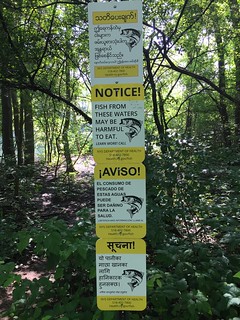While in Washington, DC, for the ALA Annual Conference, I went to the Starbucks near Gallaudet University. Gallaudet describes itself as "the premier institution of learning, teaching and research for deaf and hard-of-hearing students." Businesses near Gallaudet are more aware of the need to be accessible for all. In the business district on H Street is the first signing Starbucks in the U.S. "Signing" means that the preferred language in that Starbucks is American Sign Language (ASL). The facility was built to be accessible for all, rather than being retrofitted. It is a beautiful and peaceful (quiet) location, where all of the worker use ASL. In this facility, accessible content is being created constantly as members of the deaf and hearing communities interact.
Question: When your create a new facility or remodel an existing facility, how committed are you to creating space that is truly accessible for all?
Accessibility is also something we need to consider, when we create signage. How many languages are spoken in your community? How many languages are your signs in? While we acknowledge that many languages are spoken in our communities, we often only have signage in 1-2 languages. (Can you guess which ones?)
I'm impressed with this sign in a park along Onondaga Lake, which is in English, Spanish, Burmese and Nepali. Why? Because some people see the lake as a food source, but eating fish from this lake is not recommended. This sign to right is in four of the languages that are spoken in Syracuse. I wish there was a visual representation of the message, which would be accessible to more people.
Question: Is your library's signage in language that your community members use? Have you created frequently asked questions in multiple languages? Is there a way for your website to be automatically translated into other languages?
Going back to Starbucks for a moment, here is the manager's business card in both English and Braille. (Don't worry, there is no personal contact information on this card.)
Question: If you are interacting regularly with people who need your contact information in other languages or in a different format, have you create a business card for those situations?
Finally, I want to point out that Sabrina Unrein has written a white paper entitled “What Makes a Good Library Website?” Sabrina is an MSLIS student at Syracuse University and is working working me as part of the iSchool Public Libraries Initiative. Included in her white paper is information about web security and creating accessible content.
Question: Have you reviewed your website and all of its content to assure that everyone can use it? Is it accessible on mobile devices as well as screen readers?
Addendum (04/01/2021): If you are thinking about making your website more accessible, be sure to read this Overlay Fact Sheet.



No comments:
Post a Comment